Proven Marketing Strategies From Industry Leaders You Can Start Using Today
Marketing can sometimes feel like a game of trial and error, but a few tactics consistently hit the mark.
We’ve chatted with 16 industry pros who’ve nailed down the strategies that work, from the power of cause marketing to the smart use of content repurposing.
Here’s a look at the marketing tactics these experts can’t live without — and why they’re so effective.

1. Champion Cause Marketing
One marketing strategy example that has shown immense success is cause marketing. Patrick Beltran, Marketing Director at Ardoz Digital, explains that this approach involves partnering with nonprofit organizations and charities to support meaningful causes. By aligning your multifamily brand with a cause, you add a human element to your marketing efforts, significantly boosting consumer perception and engagement.
“Consumers genuinely feel good about their purchases when they know their money is helping provide essentials like shelter, food, or other support to those in need,” says Beltran. The key to success with cause marketing is choosing a cause you are passionate about, as this authenticity drives better results for your campaigns.
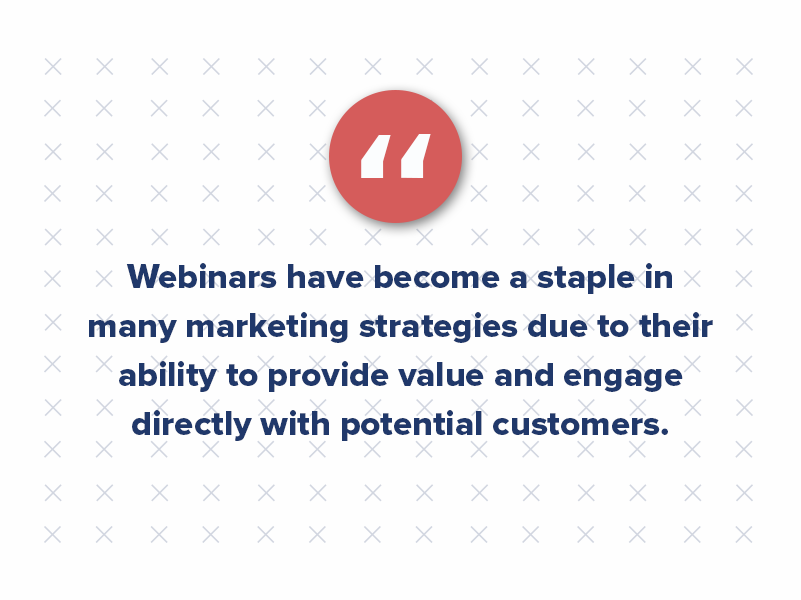
2. Host Value-Packed Webinars
Webinars have become a staple in many marketing strategies due to their ability to provide value and engage directly with potential customers. Rohit Vedantwar, Co-founder and Director at Supramind.com, highlights the effectiveness of this tactic by sharing how his team’s webinars led to a 45% increase in qualified leads and a 30% rise in product trials within six weeks.
“Webinars position our brand as a thought leader while fostering a sense of trust and authority with our audience,” says Vedantwar. By offering actionable insights and detailed product demos, webinars attract participants and drive conversions by addressing the specific needs of your audience.
3. Segment Newsletters by Interest
Personalization in marketing is crucial, and one way to achieve this is by segmenting newsletters based on subscriber interests. Meaghan Maybee, Marketing Communications Specialist at pc/nametag, shares how her team’s segmented newsletters have led to higher open rates, click-through rates, and lower unsubscribe rates.
“Our marketing team creates multiple newsletter types according to a subscriber’s unique interests,” says Maybee. This approach ensures that the content delivered is relevant to where the subscriber is in their buyer’s journey, making them more likely to engage with the emails and ultimately convert.
4. Nurture Leads with Email Campaigns
Email marketing remains one of the most effective ways to nurture leads and build relationships with potential customers. Randy Speckman, CEO at Randy Speckman Design, swears by nurturing email campaigns, sharing how a seven-email drip campaign for an online course launch significantly increased sales on launch day.
“Email nurturing works because it builds familiarity and trust over time,” says Speckman. The key to success with email marketing campaigns is providing real value in each message, which helps establish your brand as an authority in your field and encourages recipients to take action when the time is right.
5. Present at Industry Events
Industry events offer a unique opportunity to showcase your expertise and connect with potential clients face-to-face. Nicole Farber, CEO of ENX2 Legal Marketing, shares how presenting at law schools and marketing conferences has led to multiple new clients and substantial new business.
“Presenting in front of audiences allows me to showcase my knowledge and expertise,” says Farber. By establishing yourself as a thought leader and providing valuable insights, you can generate leads and build credibility in your industry.
6. Create In-Depth Content Guides
Content marketing is a powerful tool for establishing your brand’s authority and driving qualified leads. Josh Cremer, CEO and Creative Director at Redfox Visual, shares how an in-depth guide on local SEO best practices significantly increased qualified leads for his agency.
“Content works because it establishes your expertise, builds trust, and provides value to readers,” says Cremer. In-depth content guides address key concerns and questions that your audience may have, positioning your brand as a go-to resource in your industry.
7. Optimize Paid Social Media Ads
Paid social media advertising allows you to reach your target audience with precision and scale your marketing efforts. Jeff McGeary, Founder & CEO, PracticeVIP LLC, shares how paid social media ads have driven substantial new revenue for his clients.
“For small practices especially, paid social advertising is a game-changer,” says McGeary. By targeting your ideal customers and crafting relatable messaging, you can generate high-quality leads and achieve a significant return on investment.
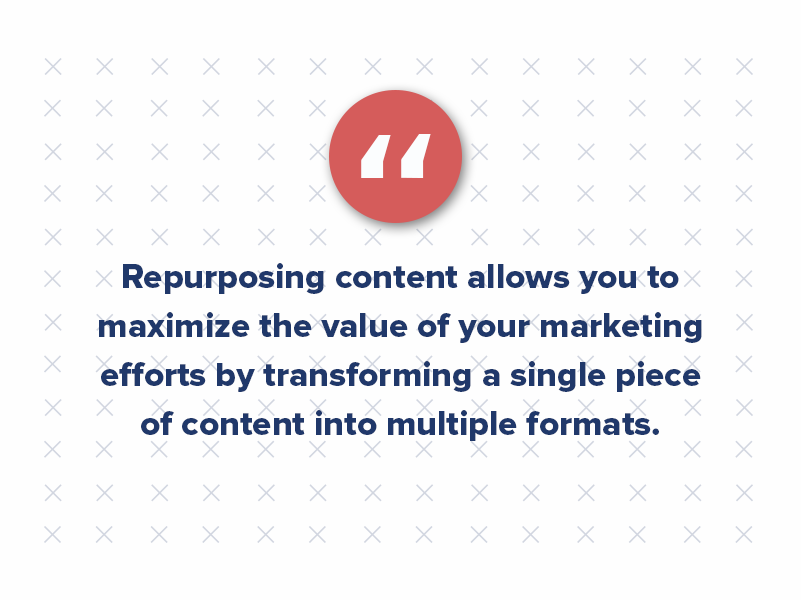
8. Maximize Reach with Content Repurposing
Repurposing content allows you to maximize the value of your marketing efforts by transforming a single piece of content into multiple formats. Vaibhav Kakkar, CEO of Digital Web Solutions, highlights how his team’s content repurposing strategy led to increased reach and engagement.
“We maximize the value of our content by transforming a single piece into multiple formats,” says Kakkar. This approach ensures that your core message reaches different audience segments, making your marketing strategies more efficient and impactful.
9. Personalize Your Email Marketing Campaigns
Personalization is key to effective email campaigns. Lauren Gast, Marketing Director at Truck Driver Institute, shares how personalized email campaigns have increased inquiries for their CDL training programs.
“It works because it creates a one-to-one and relevant relationship with the audience,” says Gast. By addressing the specific needs and interests of your audience, personalized emails can significantly boost engagement and conversion rates.
10. Showcase Customer Testimonials
Customer testimonials and case studies are powerful tools for building trust and credibility with potential clients. Tim Woda, Founder at White Peak, shares how leveraging customer testimonials led to an increase in leads and inquiries.
“Real-life success stories resonate with prospects far more than generic marketing messages,” says Woda. By showcasing the tangible benefits of your services through customer testimonials, you can convert leads into customers more effectively.
11. Produce Engaging Explainer Videos
Visual content, especially videos, is a highly effective way to communicate complex messages quickly and engagingly. Kevin Watts, President and Founder at Raincross, shares how an explainer video increased qualified leads by over 30% within the first month.
“Videos work because they can convey a complex message in a short, easy-to-understand format,” says Watts. Engaging visual content can capture the attention of your audience and drive them to take action.
12. Leverage Strategic Partnerships
Strategic partnerships allow you to tap into an established network and community, providing access to high-quality leads. Robert P. Dickey, President and CEO at AQ Marketing, shares how strategic partnerships have driven significant lead generation for his clients.
“Strategic partnerships work because you’re leveraging an established network and community that already trusts your partner,” says Dickey. By creating mutually beneficial partnerships, you can gain exposure to new audiences and drive organic growth.
13. Utilize User-Generated Content
User-generated content (UGC) adds authenticity to your marketing tactics by showcasing real customer experiences. Kam Talebi, CEO of Gigli, shares how utilizing UGC has improved their ROI and strengthened connections with customers.
“UGC is more effective than brand-generated content because it showcases the experiences that other people are having with our products,” says Talebi. Incorporating UGC into your marketing strategy can build trust and engagement with your audience.
14. Organize Industry-Specific Events
Industry-specific events directly engage your target market, making them a highly effective marketing tactic. Amar Ghose, CEO of ZenMaid, shares how organizing the “Maid Summit” significantly boosted brand awareness and generated high-quality leads.
“By bringing people together and providing valuable content, we not only increased our brand visibility but also maintained a steady flow of leads,” says Ghose. Organizing events allows you to connect with your audience on a personal level and establish your brand as a leader in your industry.
15. Tailor Marketing to Generational Segments
Understanding the unique preferences of different generational segments is crucial for crafting personalized marketing strategies. Farnam Elyasof, Founder of Flex Suits, shares how tailoring campaigns to Millennials and Gen X has optimized engagement and boosted leads.
“Being aware of generational nuances ensures that you are using the right marketing strategies to boost your leads and revenue,” says Elyasof. By addressing the specific needs and preferences of each generation, you can create more effective and relevant campaigns.
16. Offer Referral Incentives
Referral incentives are a cost-effective way to amplify word-of-mouth marketing and drive organic growth. John Cammidge, Handyman at Handyman John, shares how offering a 10% discount for referrals significantly boosted revenue and client loyalty.
“Referral incentives leverage trust — clients trust their friends’ recommendations,” says Cammidge. By rewarding existing clients for referring new customers, you can create a cycle of consistent growth and client retention.
Championing Success Through Strategic Marketing Tactics
These marketing tactics, championed by industry thought leaders, demonstrate the power of strategic, personalized, and value-driven approaches. Whether through cause marketing, personalized email campaigns, or organizing industry events, these marketing strategy examples have proven their effectiveness in driving results across various sectors. With these marketing tactics, you can enhance engagement, build trust, and achieve long-term success for your organization.

Content Marketing: Your Multifamily Brand’s Secret Weapon in Tough Times
Let’s be honest — everyone’s talking about content marketing these days, but it’s not just another buzzword when it comes to multifamily. It’s your secret weapon for building an outstanding multifamily brand identity.
Sure, multifamily inbound marketing isn’t exactly groundbreaking, but here’s the thing: it’s often misunderstood. It’s not just about chasing leads — it’s about crafting a strong online presence, boosting brand awareness, and making your property the go-to choice in a crowded market.
Why Content Marketing Should Be Top Priority (Even When Budgets Are Tight)
In a year where the mantra is “stay alive until 2025,” it’s tempting to pull back on marketing budgets and wait for the market to bounce back. However, cutting content marketing might be a mistake that could cost you more in the long run. Inbound marketing remains one of the most cost-effective strategies out there, offering a high return on investment even when budgets are tight.
Consider this: content marketing campaigns cost 62% less to launch and maintain than other marketing campaigns. Despite the lower cost, the impact is significant.
For instance, 51% of content consumption comes from organic search, meaning your content can continue to draw in traffic and build brand awareness without requiring constant ad spend. Additionally, content marketing is responsible for increasing lead generation according to 74% of companies — proof that it’s an investment worth maintaining.
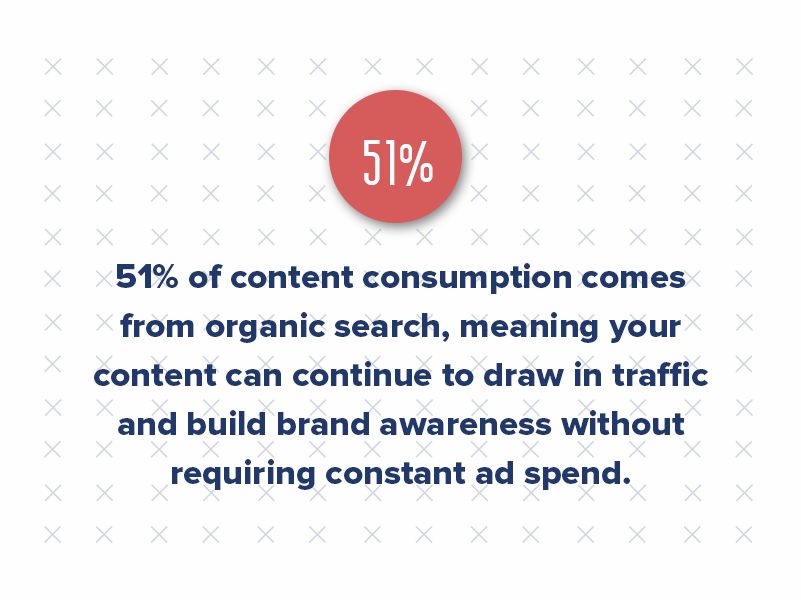
Even in tough economic times, multifamily inbound marketing provides a sustainable way to stay visible and relevant. Over a third of businesses have recognized this, allocating 10% to 29% of their budget to content marketing. High-quality content is also the most effective SEO strategy for 59% of B2C marketers, underscoring its importance in driving organic traffic and improving search engine rankings.
Moreover, the role of inbound marketing extends beyond just budget efficiency. It’s about maintaining your brand’s presence in a competitive market. With 78% of people using social media as their primary way to find information on brands, having a consistent content strategy helps ensure that your brand remains top of mind for potential customers. And businesses that integrate link-building strategies with their content marketing report a 45% greater success rate, highlighting how these efforts can amplify your overall marketing effectiveness.
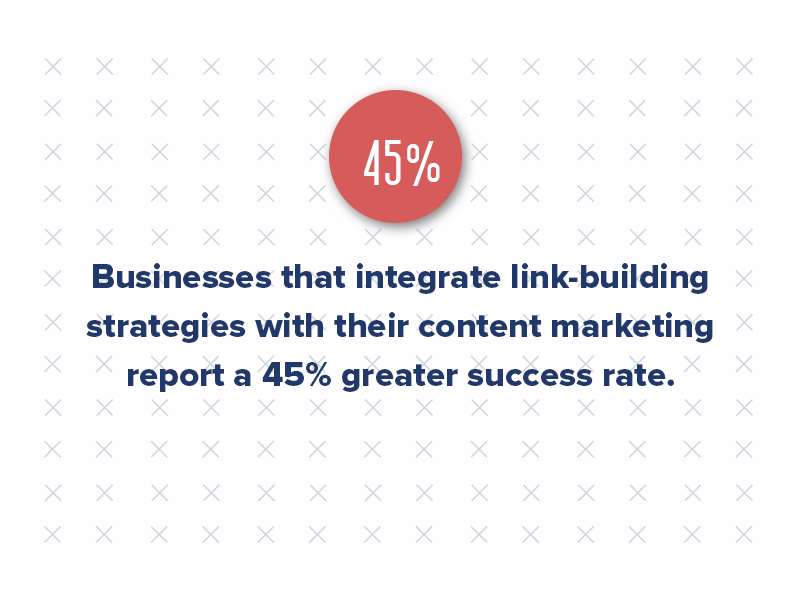
In-person events, webinars, email campaigns, organic social media platforms, and blogs are among the top-performing content marketing channels. Whether hosting a webinar or crafting a blog post, each piece of content contributes to your brand’s overall visibility and credibility.
So, while the market might be uncertain now, maintaining or doubling down on your inbound marketing efforts can position your brand for tremendous success when the economy rebounds.
Here are some additional tips for an effective content marketing strategy:
1. Start a Consistent Blogging Strategy
Blogging is a foundational element of inbound marketing that is crucial to building your brand identity. A well-maintained blog can significantly enhance your property’s visibility online. Here are some compelling reasons why:
- Increased Visibility: Websites with blogs have 434% more indexed pages, meaning they are more likely to appear in search engine results.
- Enhanced Trust: Blogs are rated as the fifth most trusted source for accurate online information.
- Brand Authority: Regular blogging helps establish your property as an authority in the multifamily industry, making it a go-to resource for potential residents.
Starting a consistent blogging strategy involves identifying the topics that matter most to your target audience and delivering content that addresses their needs and interests. This approach keeps your website active and helps build trust and credibility, essential components of a strong brand.
2. Tell Your Multifamily Brand Story
Every brand has a story to tell, and your multifamily property is no different. Your brand story is the narrative that encompasses your property’s values, mission, and the unique lifestyle it offers. Blogging and content creation are potent tools for sharing this story across various platforms, helping potential residents connect with your brand on a deeper level.
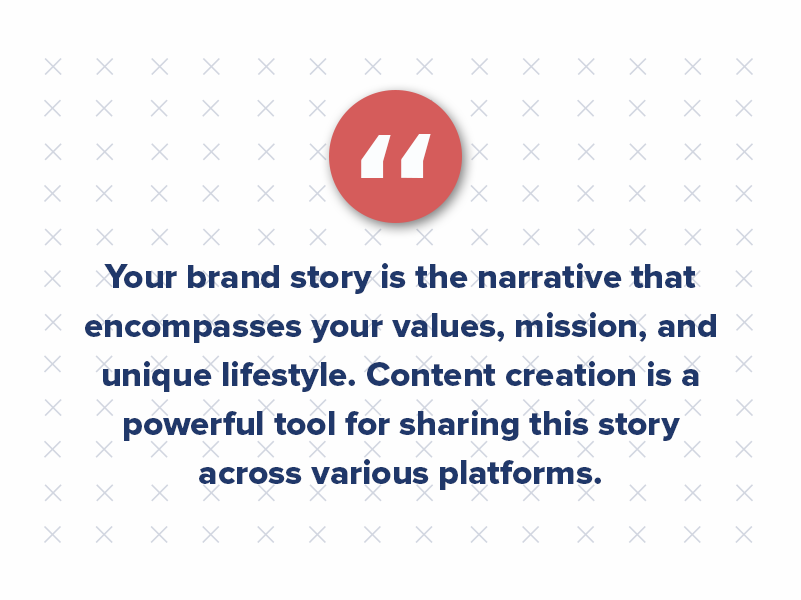
To effectively tell your brand story, consider it more than just marketing. It’s about creating an editorial vision that aligns with your brand’s identity. Whether through blog posts, social media updates, or video content, your storytelling should reflect the essence of your property and the experience it offers. This approach humanizes your brand and fosters a strong emotional connection with your audience.
3. Create Content That Resonates
Creating content that truly resonates with your audience requires a deep understanding of who they are and what they need. This is where a persona-driven strategy comes into play. By developing detailed resident personas, you can tailor your content to address your target audience’s specific pain points, desires, and lifestyle choices.
When creating content, it’s important to consider the entire customer journey. This involves crafting content that speaks to potential residents at every stage — from those just beginning their apartment search to those ready to sign a lease. By addressing the different stages of the renter’s journey — Awareness, Consideration, and Decision — you ensure that your content remains relevant and valuable, helping to build a lasting relationship with your audience.
4. Adopt a Persona-Driven Strategy
Understanding your audience is key to creating content that effectively builds your brand. A persona-driven strategy allows you to focus on your target residents’ specific needs and interests, ensuring that your content is always relevant and engaging.
Instead of trying to cover everything about your property, focus on what matters most to your audience. For example, if your target residents value sustainability, create content highlighting your property’s eco-friendly features. If your audience is primarily young professionals, focus on content that speaks to your property’s convenience and lifestyle benefits.
This targeted approach strengthens your multifamily brand identity and positions your property as the ideal choice for your target audience.
5. Maintain Consistency Across Platforms
Consistency is key to maintaining a robust multifamily brand identity. Whether it’s the tone of your blog posts, the imagery used in your social media, or the messaging on your website, everything should align with your brand’s identity. This uniformity ensures that your audience receives a cohesive message, reinforcing your brand’s presence and making it easily recognizable.
Utilizing tools like AMP Studio collateral templates can help maintain this consistency, allowing you to streamline your branding efforts across various channels. From floorplan sheets and brochures to email signatures and business cards, every piece of content should reflect your brand’s values and identity.
Why Outsource Your Content Marketing?
Outsourcing content marketing isn’t just a trend — it’s a strategic move that nearly half of all businesses embrace. In fact, 48% of content marketing is now handled by agencies or third-party companies. This approach allows businesses to leverage specialized expertise, particularly in graphic design, video production, and copywriting.
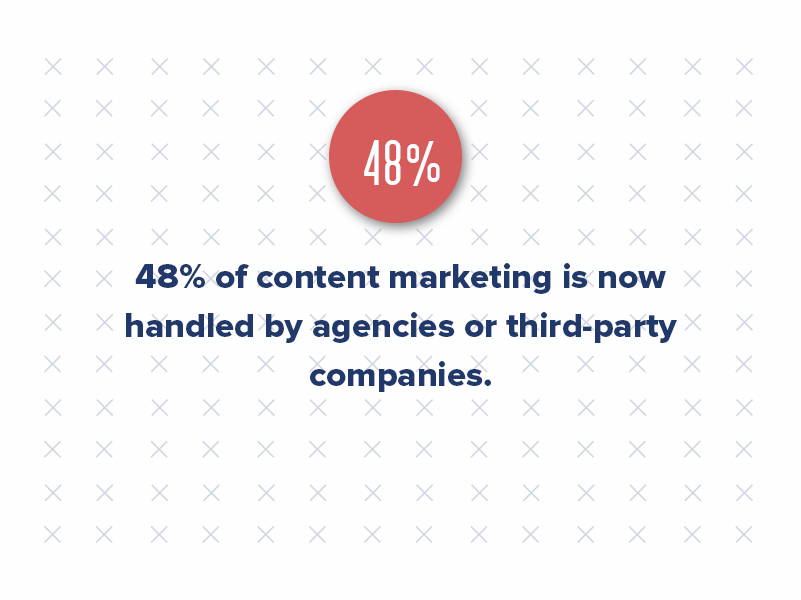
By outsourcing, you’re not just delegating tasks; you’re investing in the quality and effectiveness of your content. Consider this: 47% of outsourcing efforts focus on graphic design, ensuring that visuals are eye-catching and aligned with your multifamily brand identity. Meanwhile, 43% of businesses turn to experts for video design and animation, adding dynamic, engaging content to their marketing mix. And when it comes to articulating your brand’s message, 37% of content marketing efforts rely on professional copywriters to craft compelling narratives.
Outsourcing these creative tasks to an agency like Criterion.B can free up your time while ensuring your content is crafted with the expertise needed to resonate with your audience truly. With a team that understands the nuances of the multifamily market, we can help you build and maintain a strong, cohesive multifamily brand identity that stands out in a competitive landscape.
Make Your Brand Memorable, Not Just Noticeable
Think of multifamily inbound marketing as the cornerstone of your brand’s identity. It’s not just about getting noticed — it’s about making sure people remember you for all the right reasons. By staying consistent, you’re not just building a brand; you’re creating a lasting impression that keeps your property top of mind.
In a sea of options, being the property that stands out isn’t just nice — it’s necessary. So, invest in your content, keep it authentic, and watch as your brand is not only recognized but respected.
Here Are the Missing Pieces in Your Multifamily Marketing Plan
Content marketing in the multifamily industry has long been an afterthought — nice to have but not essential. But as multifamily marketing trends shift, it’s clear that how we create content can no longer be an experiment or an afterthought. It’s the strategy.
Property management teams relied on static flyers, cookie-cutter ads, and generic website pages for years to engage with prospective renters. Today, that’s simply not enough.
Multifamily inbound marketing is about meeting renters where they are — searching, scrolling, and researching online. That means an effective multifamily content marketing strategy must be data-driven, omnichannel, and hyper-relevant to a specific multifamily buyer persona.
At Criterion.B, we’ve worked with multifamily properties nationwide to refine their marketing campaigns and adjust to modern renters’ expectations. And if there’s one takeaway from the last five years, it’s this:
If your multifamily brand identity isn’t aligned with the multifamily brand experience, you’re leaving leads (and leases) on the table.
What Residents Expect From Your Multifamily Content Marketing
Gone are the days when content was just a blog and a few Google Ads. Modern multifamily marketing goes beyond writing informative blog posts — it’s about crafting an experience that resonates with a target audience. It’s not enough to rank on Google; you need to convert the traffic once people land on your page.
Think about it: When potential residents search for “best apartments near downtown,” they don’t just want a list of properties. They want reviews, neighborhood insights, community engagement, and compelling content that reassures them they’re making the right choice. That’s why search engine optimization (SEO) alone isn’t enough. Multifamily SEO has to work in tandem with high-quality, engaging content that educates, informs, and builds trust.
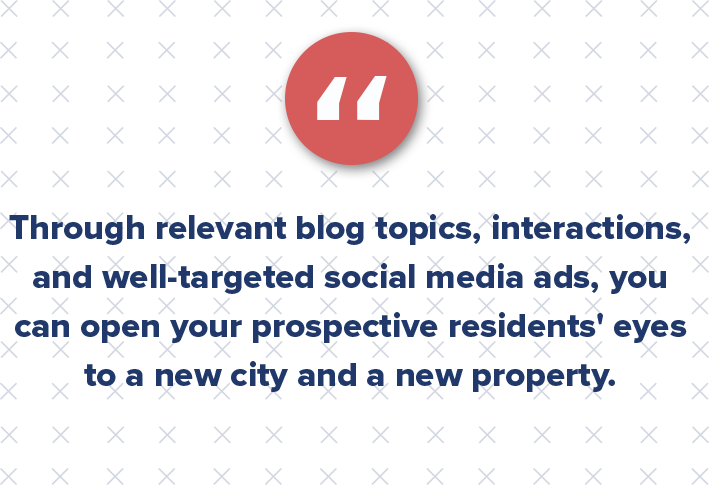
Why Is Content Marketing Still Undervalued?
The biggest misconception in multifamily inbound marketing is that content isn’t a revenue driver. Some property management teams still consider it an expense rather than a core lead generation strategy. But the reality is that content isn’t just about rankings — it’s about influence.
Content builds trust. A strong Google Business Profile with detailed posts, FAQs, and resident reviews boosts credibility. Informative videos and testimonials on a social media platform increase engagement.
A well-optimized SEO strategy ensures your property is found before competitors. And most importantly, content helps renters see themselves in your community — before they even visit.
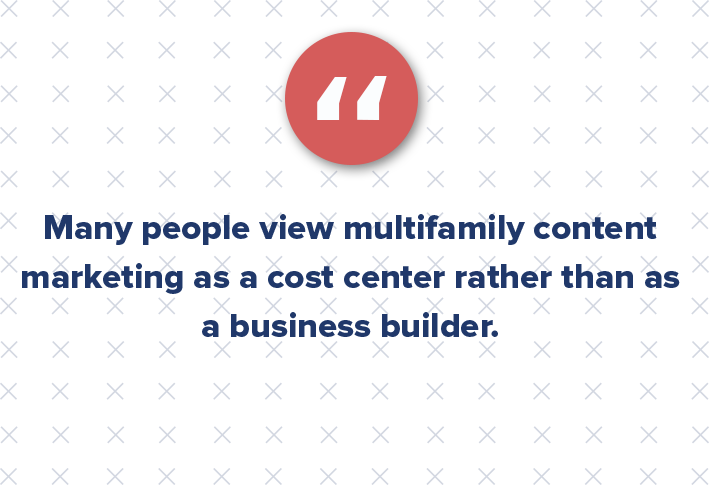
How to Build a Content Marketing Plan That Works
A successful content marketing strategy requires more than a few blog posts. Here’s what multifamily properties need to prioritize:
1. Know Your Audience, Build Your Persona
Your multifamily buyer persona determines everything: messaging, branding, social media marketing, and advertising strategy. Are you targeting young professionals, downsizing baby boomers, or remote workers? Your content must speak to their unique needs and expectations.
2. Leverage Multiple Channels
Your audience isn’t just on your website — they’re across multiple social media platforms, browsing on Google, and checking online reviews. Effective multifamily content marketing should be spread across organic search, email, video, and social media.

3. SEO + Content = Visibility
Writing great content is useless if no one sees it. Search engine optimization (SEO) is critical for long-term success. Whether optimizing for Google Business Profile, crafting data-driven blogs, or improving site structure, every piece of content should be working to increase organic traffic.
4. Prioritize Value, Not Just Promotions
Your marketing plan shouldn’t just push lease specials — it should position your property as a go-to resource. Think about content like:
- Apartment living tips
- Community guides
- Moving checklists
- Resident success stories
- Neighborhood spotlights
5. Social Media Is More Than Just Posting
Social media marketing for multifamily isn’t just about posting floorplans. It’s about storytelling. A smart multifamily branding agency will craft campaigns highlighting the multifamily brand experience, showcase resident testimonials, and engage with followers through interactive content.

Essentially, you must create great content and then adapt it across platforms. For example, a single blog post can be shared on Twitter with a snappy headline, extended to Instagram with an engaging image, and adapted to a shareable infographic.
While social networks continue to grow more visual, multifamily marketing professionals will have the opportunity to be wildly creative in their cross-platform applications.
How Do You Justify the ROI of Multifamily Marketing?
If you’re approaching your content marketing strategy correctly, you can tie your efforts directly to ROI — both qualitative (brand-focused) and quantitative (business-focused).
Let’s take Zillow, for example. Its content strategy achieves highly targeted brand goals (i.e., establishing Zillow as a storyteller within real estate) and business goals (i.e., driving traffic to its website to increase conversions). It should work the same way for your multifamily property:
- What multifamily brand goals are you trying to achieve?
- What business goals are you trying to achieve?
No matter what your business is, your content marketing actions should be driven by the questions above. Only then can you develop a roadmap with a purpose and measurable objectives.

Are You Ready for the Future of Multifamily Marketing?
We’re at an inflection point. Inbound multifamily marketing is evolving, and renters expect more. They don’t just want listings; they want an experience. The brands that succeed will be the ones that invest in content — not as an afterthought, but as the foundation of their lead generation strategy.
If your multifamily marketing still feels stuck in the past, it’s time to rethink how you connect with potential residents. Content isn’t just king anymore — it’s the entire kingdom.

Beyond the Booth: Creative Ways to Network at Multifamily Events
We’ve had clients ask us more times than not, “How do I get in front of multifamily?” “How do I market my business beyond my website and digital ads?”
The multifamily landscape is booming with new residents flooding the market and competition fiercer than ever. Whether you’re a seasoned property management firm or a disruptive proptech startup, standing out in this crowded space requires a strategic approach.

To grab the attention of multifamily decision-makers, you need to be where they are and speak their language.
Here are 10 proven ways to put your brand in front of the right people in the multifamily industry:
1. Partnering With Local Syndicators
Syndicators serve as the bridge between real estate investors and multifamily properties. By forging partnerships with these key players in your local market, you can gain valuable access to their network of potential clients. Offer resources, co-host educational events, or sponsor their newsletters to build brand awareness and trust within their investor pool.
2. Leverage Apartment Association Events
Local apartment associations host regular events and conferences that attract property managers, owners, and industry professionals. Participating in these events, like the Apartment Association of Greater Dallas, presents a fantastic opportunity to network, showcase your solutions, and connect with decision-makers directly. Attend workshops, volunteer for committees, or even sponsor the event to maximize your visibility.
3. Don’t Miss National Trade Shows
Major industry events like the National Apartment Association’s Apartmentalize offer unparalleled networking opportunities. Having a well-designed booth with engaging presentations is crucial. But don’t underestimate the power of pre-show outreach and post-event follow-up to nurture those initial connections.

4. Become a Thought Leader Through Content Creation
Multifamily professionals are busy, but they’re hungry for valuable insights. Establish your brand as a trusted resource by contributing informative articles to local and national publications relevant to the industry. Reach out to the Apartment Associations you’re connected with or publications like Multifamily Insiders and Forbes. Offer fresh perspectives, share data-driven insights, and showcase your expertise through compelling content.
5. Network Beyond Events
Networking doesn’t stop at conferences. Join online forums and social media groups frequented by multifamily professionals. Participate in discussions, answer questions thoughtfully, and be a helpful resource.
Attend industry meetups, join local business associations, and don’t hesitate to talk wherever you encounter potential clients. For example, many cities have a monthly “Business Exchange” or “Women in Commercial Real Estate” group you can join, or you can join hundreds of Facebook and LinkedIn groups relevant to your industry.

Here are a few of our favorite multifamily LinkedIn groups:
- Apartment Innovation and Marketing
- Commercial Real Estate Pros
- Commercial Real Estate Referral Network
- Multifamily Executive
- Residential Property Management Professionals
- Multifamily Insiders Community
6. Partner With Property Management Software Providers
Property management software companies have a vast network of users within the multifamily industry. Explore co-marketing opportunities with these software providers. Develop integrations with their platforms, co-host webinars, or offer joint content resources that address common pain points for property managers.
7. Utilize Online Marketing Strategies
Today, a robust online presence is critical. Invest in search engine optimization (SEO) to ensure your website ranks high when multifamily professionals search for relevant solutions. Run targeted social media campaigns on LinkedIn and Facebook to connect with decision-makers. To build a nurturing campaign, offer valuable content like e-books, whitepapers, and webinars in exchange for email addresses.
8. Leverage Customer Success Stories
Don’t underestimate the power of showcasing your success. Highlight positive client testimonials on your website and social media profiles. Consider creating case studies that showcase the quantifiable results you’ve achieved for clients within the multifamily industry.
Want to see some examples? Check out our most recent case studies on our Resource page here.
9. Participate in Industry Awards
Winning industry awards adds credibility and prestige to your brand. Research relevant awards offered by apartment associations, industry publications, or even proptech communities. Compiling a strong case study and submitting your work demonstrates your commitment to excellence and innovation, gaining the attention of potential clients. Even if you don’t win, being involved in these communities might offer you a future opportunity to participate as a judge in these competitions.
10. Build Relationships, Not Just Transactions
It’s important to remember that the multifamily industry is built on relationships. Focus on fostering genuine connections with potential clients. Listen to their challenges, understand their pain points, and tailor your solutions to their needs. By demonstrating genuine care and expertise, you’ll build trust and long-lasting partnerships that fuel your success in the competitive multifamily market.
Implementing these strategies will create a multi-pronged approach to getting in front of multifamily decision-makers. Consistency is key. Continuously put yourself out there, provide value, and cultivate relationships within the multifamily industry. Establishing yourself as a trusted resource and thought leader will attract the right clients and pave the way for your long-term growth and success.

Must-Have Marketing Tools for Building Your Online Empire
The marketing technology landscape (MarTech) can feel overwhelming. With countless tools vying for your attention, it’s easy to get lost in the “nice-to-haves” and miss the essentials for building a strong online presence and fostering meaningful engagement.
Below, we explore key tools to enhance brand awareness, audience interaction, and online visibility.
Remember, a well-defined marketing strategy is the foundation for success. These tools will amplify your efforts, not replace them.

Before diving in, consider your resources. Partnering with a multifamily marketing agency grants access to their MarTech stack, which often includes email marketing, SEO, social media management tools, and more. Utilize their expertise and potentially save on individual tool subscriptions.
1. Content Management System (CMS
Gone are the days of developer-dependent websites. User-friendly CMS platforms like WordPress empower you to add content, edit, and manage your website easily, even without coding knowledge. This translates to cost savings and frees you from relying on IT for basic updates.
But a website is more than just a digital brochure. Regularly publishing valuable content establishes your brand as an industry authority, attracts organic search engine traffic, and subtly pre-qualifies genuinely interested visitors. WordPress offers a vast library of plugins for seamless integration with other MarTech tools like Mailchimp (email marketing tools), WooCommerce (e-commerce), and Google Analytics (web analytics).
2. Unveiling Audience Insights With Google Analytics
Google Analytics, a free web analytics platform, illuminates the who, what, and why behind your website traffic. It reveals which marketing channels drive lead generation, their behavior on your site, and their actions (e.g., page views and downloads). Take your analysis further by setting up custom events and goals to track specific user actions like content downloads, form submissions, or video views. This data empowers you to tailor your content and marketing strategies for maximum impact and return on investment.

3. Social Media Management Tools
Platforms like Hootsuite or Buffer streamline social media scheduling, allowing you to manage multiple accounts and ad campaigns and post consistently across various platforms. This keeps your brand buzzing and fosters audience interaction.
Tools like Brandwatch or Sprout Social can also help you monitor online conversations about your brand and industry trends. This allows you to identify areas for improvement, address customer concerns, and participate in relevant conversations.
Remember, the ideal MarTech stack is a blend of tools that empower your unique marketing efforts.
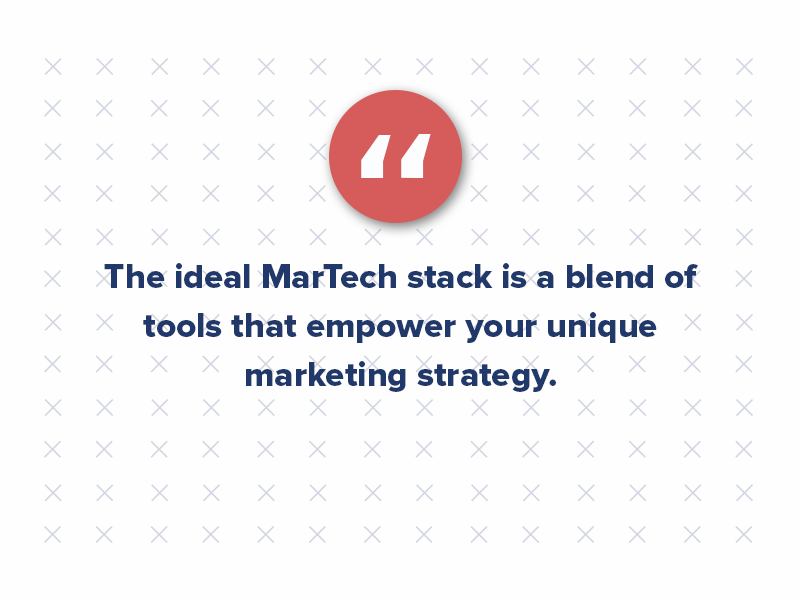
4. Graphic Design Tools
Eye-catching visuals are essential for grabbing attention and boosting engagement. Design tools like Adobe Creative Suite (powerful but complex), ProCreate (ideal for artists on iPads), or Canva (user-friendly and budget-conscious) empower you to create professional-looking social media graphics, infographics, and other visual content.
5. Search Engine Optimization (SEO)
Technical SEO ensures your website adheres to search engine guidelines, making it easily discoverable by potential customers. Tools like Semrush, SEO Moz, and Ahrefs offer website audits, keyword research, and competitor analysis, helping you optimize your site for relevant search terms. By improving your search ranking, you organically attract a wider audience interested in what you offer.
6. Nurturing Relationships With Email Marketing Tools
Building lasting connections with your audience is key to brand loyalty. Email marketing tools let you share valuable content, announce promotions, and keep your brand top-of-mind. While standalone tools like Mailchimp exist, marketing automation platforms like Go High Level, SharpSpring, and HubSpot often include built-in email marketing functionalities. These tools allow for automated email sequences and email campaigns that nurture and keep multifamily leads engaged over time.

7. Webinars and Online Events
Platforms like Zoom or GoToWebinar allow you to host live events, product demos, or industry discussions. This is a fantastic way to connect with your audience in real time and showcase your expertise.
8. Marketing Automation Software
Marketing automation software takes your MarTech toolbox to the next level. These tools automate repetitive tasks, allowing you to focus on high-level strategy, marketing campaigns, and nurturing relationships.
Here’s how they can benefit your business:
- Automated Workflows: Create pre-defined sequences for nurturing leads, sending personalized messages based on user behavior, and automating follow-up emails. This frees up your time for more strategic initiatives.
- Lead Scoring and Segmentation: Assign scores to leads based on their engagement level and website activity. This helps prioritize leads and personalize communication for maximum impact.
- Omnichannel Marketing: Deliver targeted messages across multiple channels, including email, social media, and SMS, for more cohesive brand and customer experiences.
When selecting marketing automation software, a property manager should budget, team size, and marketing goals for the property. Look for features that align with your needs and offer scalability as the property grows.
Propel Your Business Forward With MarTech
The MarTech landscape is vast, and the “best” tools depend on your needs and budget. Start by focusing on a core set of tools that align with your strategy and gradually expand your multifamily marketing channels as your online presence evolves. Leveraging these resources allows you to establish a strong online brand, cultivate a loyal audience, and propel your business forward.

Expert Tips to Avoid Property Management Nightmares
The life of a property manager is a juggling act. You’re responsible for everything from resident relations and maintenance to budgeting and legal compliance. It’s no wonder that mistakes can happen, especially for new property managers or those managing a growing portfolio.
The good news is that by identifying common pitfalls, you can take proactive steps to avoid them.
Here’s a look at some of the biggest mistakes property managers make, along with actionable tips to keep your properties running smoothly:
1. Failing to Properly Screen Residents
A bad resident can be a nightmare for any property manager. They can damage the property, disrupt other residents, and drain your time and resources.
The fix? Implement a thorough screening process that includes credit checks, rental history verification, employment verification, and reference checks. Don’t skip this crucial step — a bad resident can cost you far more in the long run than a thorough screening process ever will.

2. Not Having Clear Lease Agreements
A well-written lease agreement protects both you and your residents. It should clearly outline the rights and responsibilities of both parties, including rent amount, due dates, late fees, pet policies, maintenance procedures, and termination clauses.
The fix? Use a standardized lease agreement that has been reviewed by a lawyer. Keep it updated with any local or state regulations that may change.
3. Letting Maintenance Requests Pile Up
Prompt and thorough maintenance is a cornerstone of successful property management. Like addressing resident complaints quickly, addressing maintenance requests swiftly is essential to avoid a cascade of negative consequences.
Here’s why prioritizing maintenance is crucial:
- Protecting Your Investment: Regular maintenance plays a vital role in preserving the condition of your properties. Neglecting repairs can lead to further deterioration, decreased property value, and higher operating costs. Think leaky faucets that escalate to water damage or clogged gutters that lead to foundation issues. Addressing minor issues promptly saves you money in the long run.
- Resident Satisfaction & Safety: Living in a well-maintained property contributes significantly to resident satisfaction. Ignoring maintenance requests creates frustration and a sense of neglect. Prioritizing repairs ensures a safe and comfortable living environment for your residents.
- Reduced Liability: Letting maintenance issues linger can expose you to legal trouble. For instance, a slip and fall because of an unaddressed ice patch on the sidewalk could result in a lawsuit. By promptly addressing maintenance requests, you’re mitigating potential liability risks.
Here’s how to ensure your properties are well-maintained:
- Routine Inspections: Schedule regular inspections of your properties to identify potential problems before they become major issues. This could involve monthly walkthroughs or annual comprehensive inspections.
- Qualified Contractors: Develop relationships with qualified and reliable contractors who can handle various maintenance tasks. Verify references to confirm licensure and insurance. Oversee the quality and timeliness of their work to ensure efficient repairs.
- Budgeting for Maintenance: Don’t underestimate the importance of budgeting for maintenance and repairs. Factor in routine maintenance costs and a reserve fund for unexpected emergencies and major repairs. This ensures you have the resources readily available when needed.
- Communication Is Key: Like with resident complaints, keep residents informed throughout the maintenance process. Acknowledge their request promptly, explain the repair timeline, and provide updates if any delays occur. Open communication fosters trust and reduces frustration.
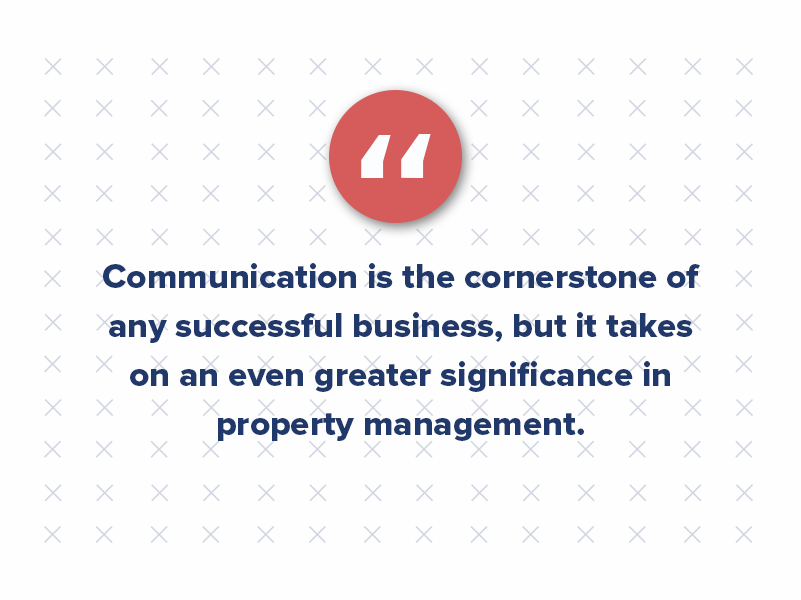
4. Poor Communication With Residents
Communication is the cornerstone of any successful business, but it takes on an even greater significance in property management. You’re constantly juggling interactions with a diverse group — your team members, property owners, residents, and vendors. When communication breaks down, it can lead to misunderstandings, conflicts, delays, errors, and ultimately, dissatisfied customers.
Here’s how to ensure smooth communication:
- Establish Clear Channels: Don’t leave your team and renters guessing how to reach you. Set up designated communication channels — email, phone calls, text messages, or online platforms like resident portals. Consistency is key — don’t make them chase you down across multiple platforms.
- Frequency & Transparency: Aim for frequent, transparent communication. Regular updates keep everyone informed and in the loop. Don’t be afraid to share both good and bad news promptly and honestly.
- Tailored Communication: A one-size-fits-all approach won’t work. Tailor your communication style to your audience. Use clear and concise language with residents, provide detailed reports to property owners, and foster open collaboration with your team.
- Feedback & Listening: Communication is a two-way street. Listen to your team and renters’ concerns, questions, and suggestions. Provide positive and constructive feedback to keep everyone motivated and on track. Respond promptly and professionally, demonstrating that their input is valued.
- Technology Advantage: Fortunately, technology is on your side. Utilizing property management software streamlines communication by centralizing information, automating tasks, and facilitating easy access for all parties involved. This reduces the risk of errors and keeps everyone on the same page, boosting overall efficiency.
- Building Relationships: Effective communication goes beyond simply sharing information. It’s about fostering trust and building strong relationships. Schedule regular team meetings to discuss projects, address concerns, and celebrate successes. Open communication fosters a collaborative environment where everyone feels comfortable contributing their best work.
5. Not Keeping Records and Documents
Failing to organize and store important documents properly can lead to a domino effect of problems, including missing records. Missing or disorganized records can make tracking important information (i.e., lease agreements, maintenance requests, and financial transactions) difficult. This can lead to confusion, errors, and wasted time.
Without clear documentation, disputes with residents over rent payments, security deposits, or repairs can become tangled. Without proper records, you may be unable to defend your position in a legal dispute, potentially resulting in hefty fines or even lawsuits.
Here’s how to ensure your records are organized, secure, and accessible:
- Secure Storage: Utilize a secure and accessible system for storing your records. Cloud-based storage solutions offer convenience and accessibility, while traditional filing cabinets can work for paper documents.
- Regular Review and Updates: Don’t let your records become an archive of forgotten paperwork. Schedule regular reviews to ensure all documents are accurate and up-to-date.
- Compliance With Regulations: Retention laws vary depending on your location. Familiarize yourself with the relevant regulations regarding record keeping and disposal. Understanding these requirements ensures you’re adhering to legal mandates.

Effective record-keeping is a fundamental skill in property management. Most real estate transactions involve a mountain of paperwork — lease agreements, maintenance records, financial statements, and more.
Maintaining electronic copies alongside physical documents is essential in today’s digital age. This allows you to access crucial information even when you’re away from the office, ensuring you can always stay on top of your business.
6. Not Taking Advantage of Technology
Many property management software solutions can streamline your workflow and save you time. These tools can help you with tasks like screening residents, collecting rent online, managing maintenance requests, and generating reports. The fix? Research property management software options and find one that fits your needs and budget. Many offer free trials, so you can test them before committing.
7. Not Marketing Your Properties Effectively
Vacancies cost money. There’s no sugarcoating it. A well-defined multifamily marketing strategy is essential to attract qualified residents and keep your properties occupied.

Don’t put all your eggs in one basket. Utilize a diverse range of multifamily marketing channels to reach your target audience. This could include:
- Online Listings: High-quality listings on popular rental platforms are a must-have. If possible, showcase your properties with professional photos, detailed descriptions, and virtual tours.
- Social Media Marketing: Use social media to connect with potential residents. Share engaging social media posts, run targeted ads, and create a community around your properties.
- Website Presence: A professional website is a valuable asset. It lets you showcase your properties, provide leasing information, and establish your brand identity.
- Offline Strategies: Don’t underestimate the power of traditional methods. Yard signs, local print ads, and partnerships with businesses in your area can still be effective ways to reach potential renters.
While a do-it-yourself approach is possible, managing a comprehensive marketing strategy can be time-consuming, especially as your portfolio grows. This is where partnering with a marketing agency can be a game-changer.
Think of a marketing agency as an extension of your multifamily property team. They can provide a wealth of expertise and resources to help you achieve your marketing goals and increase your bottom line.
Here are just a few of the ways a marketing agency can streamline your marketing efforts:
- Streamlined Marketing Collateral: Ordering eye-catching flyers, brochures, and other marketing materials can be a hassle. Criterion.B offers a one-stop shop for designing and ordering all your promotional needs to save time and ensure brand consistency.
- Actionable Analytics & Reporting: A good marketing agency will leverage analytics tools to track the performance of your marketing campaigns. This data can reveal valuable insights into what’s working and what’s not. They can help you set up and track key metrics like website traffic, lead generation, and conversion rates.
- Search Engine Optimization (SEO): Improving your website’s ranking in search results so potential residents can easily find your listings.
- Email Marketing: Creating targeted email campaigns to nurture leads and connect with potential renters.
- Blogging and Content Creation: Developing engaging content that showcases your properties and attracts qualified leads via a blog post.
- Social Media Management: Creating engaging content and managing interactions with potential residents across all social media channels.
- Branding and Design: Developing a strong brand identity for your property management company, including logo design and website creation.
- Website Development and Management: Building a user-friendly website that showcases your properties and provides a seamless leasing experience.
8. Not Staying Up-to-Date on Industry Trends
The property management industry constantly evolves, with new technologies and regulations emerging. Staying informed is important to ensure your business runs as efficiently and effectively as possible.
The fix? Attend industry conferences, webinars, and workshops. Read industry publications and blogs to stay up-to-date on the latest trends.
Want quick marketing tips and multifamily trends delivered straight to your inbox once a week? Sign up for our weekly email list to stay informed!

9. Ignoring Complaints & Not Focusing on Resident Retention
High resident turnover can be a major drain on your resources. It involves advertising costs of vacant units, showing apartments, screening new renters, and processing paperwork. It can also result in a loss of rental income during vacancy periods. But the hidden costs are even greater — negative reviews, a damaged reputation, and a revolving door of unhappy residents.

Here’s how to cultivate a thriving community that keeps renters happy:
- Treat Renters with Respect: Building positive relationships starts with respect, courtesy, and professionalism. Respond to their needs and concerns promptly and effectively.
- Responsive Complaint Resolution: A well-defined system for handling complaints is essential. This includes a clear process for receiving, recording, and resolving issues. Respond quickly to complaints to explain how you’ll address the problem. Keep residents updated throughout the process, and follow up after the repair.
- Value Feedback and Communication: Open and transparent communication is key. Encourage feedback. Regularly solicit their input through surveys, resident meetings, or suggestion boxes. Actively listen to their concerns and suggestions, demonstrating their input is valued.
- Offer Incentives for Renewals: Show your existing renters how much you appreciate them by offering incentives for lease renewals. This could include discounts on rent, free parking, or waived application fees.
- Create a Sense of Community: Help your residents feel like they belong! Organize fun events, create social media groups for them to connect, or offer amenities that encourage interaction. When residents feel like part of a community, not just renters in a building, they’re more likely to want to renew their leases.
10. Micromanaging Your Team & Not Delegating Tasks
Learning the art of delegation becomes increasingly important as your property management portfolio expands. While you may be tempted to hold onto the reins and meticulously manage every detail yourself, this approach is ultimately unsustainable and can hinder your long-term success.
Micromanaging your team can have several negative consequences. It can stifle their motivation, creativity, and sense of autonomy. Constantly hovering over their shoulders can make them feel like they’re not trusted to do their jobs effectively, decreasing morale and productivity.
The solution lies in empowering your team through effective delegation.
- Delegate Based on Strengths: Analyze your team members’ skills, experience, and interests. Assign tasks that align with their strengths and allow them to develop new skills.
- Trust and Autonomy: Once you’ve delegated a task, trust your team to complete it without your constant oversight. Micromanaging every step is a recipe for frustration and resentment.
- Support and Resources: Provide your team with the necessary resources for success, such as training materials, software tools, and clear guidelines.
- Coaching for Growth: Don’t hesitate to offer guidance and support as needed. Regular check-ins and constructive feedback can help your team members grow in their roles.

Often, managers who micromanage their teams worry their employees aren’t doing a good job. If you don’t communicate well with your team or can’t motivate them, they might not feel like doing their best work. Instead of hovering over them, invest in becoming a better leader. Learn how to communicate clearly and build a team environment where everyone feels trusted and responsible for their work.
Remember, you hired your team for a reason — you believe in their skills and potential. Start by delegating smaller projects that allow them to demonstrate their capabilities. As they gain confidence and experience, gradually increase their scope of responsibility. If they hit a roadblock, provide coaching and support to help them develop the skills they need to reach the next level.

Achieve Smart Marketing With a Commercial Real Estate Agency
Imagine this: your meticulously designed office space sits vacant, a pristine canvas gathering dust. Or maybe your trendy apartment community struggles to attract qualified residents despite boasting top-notch amenities.
Simply having a fantastic commercial property isn’t enough. You need a strategic multifamily marketing plan that cuts through the noise and positions your offering as the ideal solution for your target audience.
This is where a commercial real estate marketing agency steps in, acting as your compass and confidant.

We’re talking about more than just slapping a “for lease” sign on the door. A good agency, like Criterion.B, can become your one-stop shop for commercial real estate marketing, encompassing both multifamily and non-residential properties.
Whether you’re a seasoned property owner or a newcomer to the market, navigating the complexities of digital multifamily marketing, crafting a compelling campaign, or establishing a distinct multifamily brand can feel overwhelming. This is where a multifamily marketing agency, like our team at Criterion.B, can be your secret weapon. We specialize in crafting unique brand narratives and developing data-driven strategies that resonate with your target audience.
The Evolving Landscape of Commercial Real Estate Marketing
You can no longer rely solely on traditional methods like print ads and cold calls. Today’s residents and tenants are digitally savvy, demanding a seamless online experience that showcases your property’s unique value proposition. This shift necessitates a comprehensive strategy that integrates various channels, including:
- Digital Marketing: This encompasses website optimization, search engine marketing (SEM), social media marketing (SMM), and targeted online advertising to ensure your property reaches the right audience at the right time.
- Content Marketing: Creating valuable content like blog posts, case studies, and whitepapers establishes you as a thought leader and attracts potential residents actively researching their options.
- Email Marketing: Fostering strong relationships with potential and existing tenants through targeted email campaigns nurtures leads and keeps your property top-of-mind.
- Public Relations (PR): Leveraging media relations and strategic partnerships can enhance your brand reputation and generate positive publicity for your property.
- Data Analytics: Measuring and analyzing marketing campaign performance is crucial for optimizing your strategy and maximizing return on investment (ROI).

Why Partner with a Commercial Real Estate Marketing Agency?
Managing all these diverse marketing elements in-house can be daunting, especially for busy property owners and managers. Here’s where a commercial real estate marketing agency like Criterion.B can be a game-changer:
Expertise and Experience
Our team comprises seasoned professionals who deeply understand the commercial real estate industry and the current marketing landscape. We stay ahead of emerging trends and best practices to ensure your marketing strategy is always optimized.
Strategic Planning and Execution
We work closely with you to understand your specific property goals and target audience. Then, we develop a customized multifamily marketing plan that aligns with your budget and objectives. Our team handles the entire execution process, from content creation and graphic design to campaign management and reporting.
Data-Driven Approach
We leverage data analytics to track the performance of your marketing campaigns and make data-driven decisions that maximize results. We provide you with regular reports and insights to ensure transparency and keep you informed of the impact of your marketing efforts.
Enhanced Brand Storytelling
We help you craft a compelling brand narrative that resonates with your target audience and differentiates your property from competitors. Our team also creates high-quality marketing materials and branded promo items that showcase your property.

Criterion.B: Your Trusted Partner for Commercial Real Estate Marketing Success
At Criterion.B, we believe in the power of strategic marketing to unlock the full potential of your commercial real estate assets. We are passionate about helping our clients achieve their business goals by developing and implementing marketing strategies that generate engagement, improve your brand presence, and set your properties up for success.
Here’s what sets Criterion.B apart:
- Proven track record: We have a proven history of success in helping commercial real estate owners and managers achieve their marketing goals.
- Client-centric approach: We tailor our services to your needs and budget, ensuring you maximize your multifamily marketing investment.
- Data-driven insights: We base our recommendations on data and analytics to ensure your marketing strategy is always optimized for results.
- Creative and innovative solutions: We think outside the box to develop unique and effective marketing campaigns that capture attention and drive results.
- Transparent communication: We keep you informed every step of the way and provide you with regular reports on the performance of your marketing campaigns.
Ready to Take Your Multifamily Property to the Next Level?
If you’re a property manager looking to navigate the complexities of commercial real estate marketing and achieve your goals for your multifamily property, partnering with a qualified agency like Criterion.B is a strategic decision.
Contact us today for a free consultation and discover how we can help you unlock the full potential of your multifamily community. Together, we can create a winning marketing strategy that positions your property at the top of search results for prospective residents.
Imagine this: a seamless online presence showcasing high-quality photos and virtual tours of your stunning floor plans. Our data-driven approach will ensure your multifamily property appears in all the right marketing channels, increasing engagement and bringing more prospects to your leasing agents. Our multifamily branding agency expertise allows us to craft a unique and memorable brand identity to make your property stand out.
Let Criterion.B be your partner in success. We’ll help you develop a comprehensive marketing strategy that leverages the power of various marketing channels, virtual tours, and a strong online presence to showcase your multifamily community and turn interest into satisfied residents.

How to Slay Your Multifamily Marketing Campaigns
Ever dreamt of launching a killer marketing campaign, only to get bogged down in endless email chains about flyers? Or maybe crafting fresh content feels like scaling Mount Everest while juggling resident requests?
If you’re a property manager, these scenarios are probably all too familiar.
The truth is, even the best marketing ideas can get stuck in a rut, thanks to some common pain points.
But fear not! Here’s the good news: we’re about to expose these pitfalls and offer solutions to streamline your processes and make your marketing a breeze.

1. Ordering Marketing Collateral
Imagine this scenario: You have a brilliant marketing campaign in mind, but its execution hinges on securing eye-catching flyers, high-quality brochures, and branded swag.
Sounds simple, right? Not always.
Ordering these seemingly basic materials often gets bogged down in many back-and-forth emails with vendors. You spend hours negotiating quotes, sifting through design options, and chasing approvals. When you finally get your hands on the finished product, you have lost valuable time and marketing momentum.
Solution: Consider utilizing a centralized online platform like AMP Studio by Criterion.B. This platform streamlines the marketing collateral ordering process by offering a curated selection of pre-approved marketing materials, move-in gifts, promotional items, and uniforms.
No more wading through endless vendor options or managing multiple usernames and passwords. Properties receive a unique link for ordering, ensuring standardization, quality, and cost-efficiency. Plus, AMP Studio automates communication with your internal teams for approvals and facilitates seamless billing.

2. Creating (Quality) Content
Creating fresh, engaging content that resonates with your target audience is a constant struggle. We get it. Between a million and one property management duties, who has time to become a content creation rockstar?
Here’s the good news: generative AI platforms like Gemini, Bard, and ChatGPT can be your secret weapon for brainstorming content ideas and churning out preliminary drafts. Need a blog post on the top dog-friendly cafes near your property? These AI tools can whip you up a decent starting point quickly.
But hold on a sec before you hand over the reins entirely. While AI can be a great time-saver, it can’t replace the human touch. Here’s why:
- Understanding Your Audience: AI might be able to analyze data and identify trends, but it can’t truly understand the nuances of your target audience. Human writers can tap into their experience and empathy to craft content that resonates deeper, addressing your residents’ specific pain points and aspirations.
- Injecting Personality: AI-generated content can often feel robotic and generic. Human writers, on the other hand, can infuse your brand voice and personality into the content, making it more engaging and memorable.
- Strategic Storytelling: Great content isn’t just about facts and figures; it’s about weaving a compelling narrative. Human writers excel at crafting stories that capture the reader’s attention and connect with them emotionally.
The Bottom Line: Think of generative AI as a helpful sidekick, not a superhero. Leverage its capabilities to streamline your content creation process, but don’t underestimate the power of human expertise in crafting content that resonates and drives results.
Solution: Our team of experienced writers and marketing specialists can work alongside you to develop a content calendar packed with engaging content that attracts and converts qualified leads. We’ll help you leverage industry trends and resident voices to make your content stand out, ensuring your property becomes a magnet for dream residents.
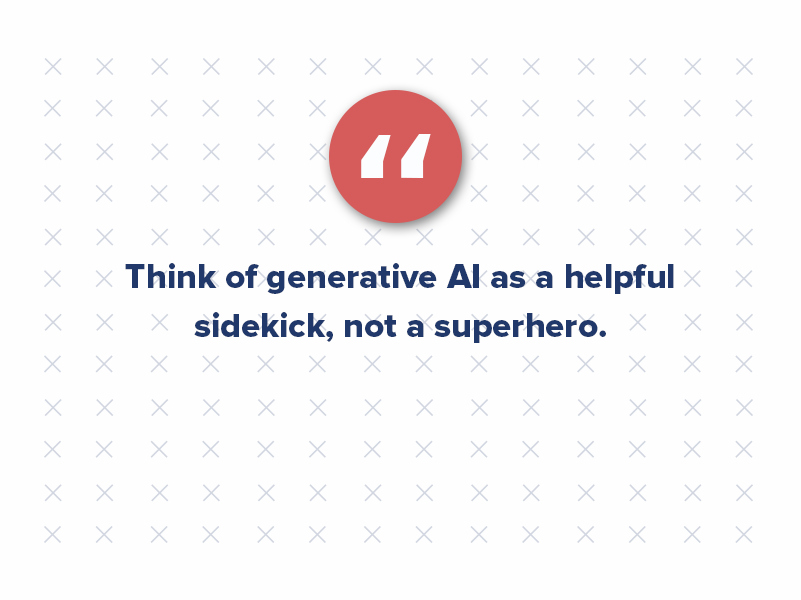
3. Tracking Analytics & Making Sense of the Data
Understanding your target audience and tracking the effectiveness of your marketing efforts is crucial. However, sifting through mountains of data from various sources can be overwhelming. With clear insights, optimizing your campaigns and allocating resources efficiently is easier.
Solution: Let Criterion.B help you navigate the data deluge. We can provide expert analysis to help you understand what’s working and what’s not in your marketing strategy. We’ll help you identify key metrics to track progress and leverage data-driven insights to optimize your campaigns for maximum impact.
4. Leveraging Social Media & Facebook Ads
Reaching the right audience with the right message at the right time can feel like a constant guessing game. Traditional marketing methods often cast a wide net, potentially wasting resources on unqualified leads. Meanwhile, social media demands constant vigilance to ensure your target audience sees your messaging.
Solution: Criterion.B can help you refine your targeting strategy and leverage the power of social media marketing and targeted advertising. We can help you create laser-focused buyer personas to ensure your marketing efforts resonate with the right people. Additionally, we can develop targeted advertising campaigns across various platforms to maximize reach and engagement.

5. Managing Multiple Vendors & Third Parties
Marketing budgets are often under constant scrutiny. Balancing creativity with cost-effectiveness can be a real balancing act. Trying to juggle multiple marketing vendors and projects can easily eat away at your precious resources.
Solution: Partnering with Criterion.B offers a cost-effective solution. Our team offers a comprehensive suite of marketing services, eliminating the need to manage multiple vendors. We work closely with you to develop a strategic plan that aligns with your budget and marketing goals.
Marketing Magic, Not Marketing Mayhem
Imagine this: you’ve nailed down the perfect marketing strategy to attract dream prospects and keep your NOI high. Now, picture yourself free from the daily marketing grind, focusing on what truly matters — managing your thriving business.
This isn’t just a fantasy. You can transform your marketing efforts from a frustrating slog to a strategic superpower by tackling these common pain points. But here’s the secret weapon: you don’t have to go it alone.
Partnering with a multifamily branding agency like Criterion.B and utilizing AMP Studio is like having a team of marketing ninjas in your corner. We’ll handle the heavy lifting — from crafting captivating content to streamlining collateral ordering — so you can focus on what you do best.
Think of it this way: a seamless multifamily marketing strategy frees up your time and resources, allowing you to invest in your business. The result? A thriving organization where prospects feel valued.
Now, that’s a win-win situation worth celebrating.

Multifamily Marketing vs. Advertising: Stop Confusing Them & Start Winning!
The digital marketing landscape constantly evolves with new tools and emerging trends. One of the hottest topics is generative AI, a powerful tool that transforms content creation and customer engagement.
But even with all these exciting advancements, a fundamental question remains: What’s the difference between marketing and advertising?
Understanding this distinction is critical to reaching your target audience. While both aim to influence people’s thoughts about your products or services, they take different approaches.
Let’s break it down and explore how generative AI plays a role in this ever-changing field.
Advertising: The Bullhorn With a Target
Think of advertising as a paid announcement. It’s a way to create buzz and let potential customers know about your offerings. Ads on social media platforms, billboards, or TV commercials are all examples. They grab attention and often tell people what to do next, like visit a website or make a purchase.
Imagine a real estate company in Dallas-Fort Worth, where construction is booming. They might use eye-catching billboards to advertise their services. These billboards act as ads, drawing attention and connecting with potential clients.
Marketing: The Mastermind Behind the Scenes
Marketing is the bigger picture. It’s a strategic plan that includes everything from figuring out your unique selling proposition (USP) to creating content and managing customer relationships. It sets the stage for impactful advertising.
Here’s how marketing helps create powerful advertising:
- Finding Your “Why”: Marketing enables you to understand what makes your company special. This unique value proposition is the foundation of all your marketing efforts, including advertising.
- Knowing Your Audience: “Buyer personas” are detailed profiles of your ideal customers. They consider age, interests, and problems your product can solve. By understanding your target audience, you can craft advertising messages that resonate with them.
- Building Relationships: Today’s consumers want a conversation. Marketing helps you create a two-way dialogue with your audience on social media platforms or through email marketing. This builds trust and loyalty, something paid advertising alone might need help.
Content Is King (and Queen)
People are more likely to pay attention to exciting content than flashy ads. Statistics show that content marketing, such as blog posts or social media content, can yield a better return on investment (ROI) than traditional advertising.
We all get bombarded with ads. The key is to make them relevant, not annoying. Here’s where targeted advertising comes in.
Digital Advertising Gets Personal
Digital advertising is no longer a one-size-fits-all approach. Enter Personalized Ads: A New Era.
With targeted ads, messages are carefully crafted to resonate with specific buyer personas, taking into account demographics, interests, and online behavior. This shift from generic advertising to hyper-personalized messaging makes ads less intrusive and more relevant, potentially transforming them from an annoyance into a useful tool.
However, successful marketing goes beyond advertising. A strong social media presence, engaging content, and excellent customer service are crucial for building brand loyalty and fostering positive customer experiences.
The digital marketing landscape continues to evolve, and businesses that can adapt their strategies to leverage the power of personalization, prioritize audience engagement across channels like social media, and deliver exceptional customer service will be the ones that thrive.
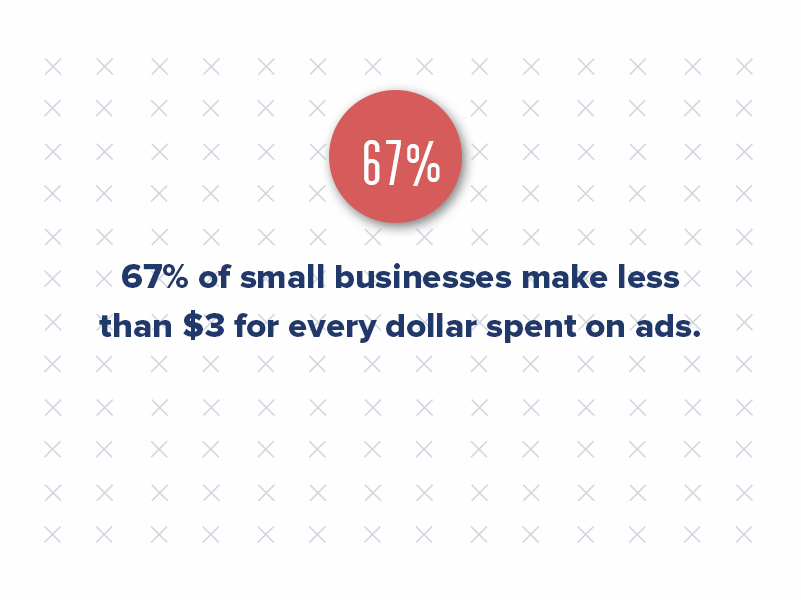
Paid Media Still Works
While content marketing is powerful, paid advertising remains valuable. It’s cost-effective and has a proven track record of success.
However, the key is to be smart about your approach. 67% of small businesses make less than $3 for every dollar spent on ads. If your ad spending often yields diminishing returns, then it’s time to rethink your marketing approach.
Here’s where a comprehensive marketing strategy comes in. By understanding your target audience and creating engaging content for them, you can lay the groundwork for successful paid advertising campaigns.
Additionally, staying on top of the latest digital marketing trends, including content creation and influencer marketing, is crucial to maximize your ad spend.
New technologies like generative AI can help you optimize your paid media efforts. AI can automate repetitive tasks like ad creation and targeting, allowing you to focus on strategic decision-making. Additionally, AI can analyze vast amounts of data to identify the most effective ad placements and messaging for your target audience.
With a well-rounded multifamily marketing strategy and leveraging cutting-edge AI tools, you can significantly improve your return on ad spend and reach your target audience more effectively.
The AI Revolution
Artificial intelligence (AI) is shaking things up in marketing and advertising. Here are some ways AI is changing the game:
- Content Creation Powerhouse: AI can create high-quality content like product descriptions and social media posts, freeing marketers to focus on more significant ideas.
- Super-Personalized Marketing: AI can analyze vast amounts of data to understand customer preferences. This allows for hyper-personalized marketing campaigns, delivering the right message to the right person at the right time.
- Marketing on Autopilot: AI can automate repetitive tasks like managing campaigns and optimizing ads, freeing marketers to focus on creative strategies that drive higher conversion rates.
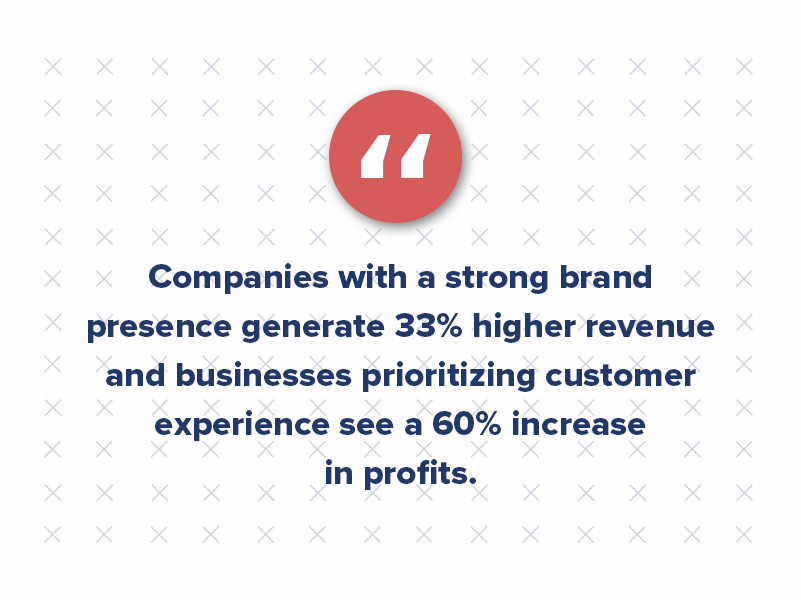
The Future Is Engaged and Data-Driven
When used strategically, marketing and advertising can be a game-changer for your business. Companies with a strong brand presence generate 33% higher revenue. Likewise, businesses prioritizing customer experience see a 60% increase in profits.
A well-executed multifamily marketing strategy that leverages AI and prioritizes audience engagement is no longer a luxury — it’s a necessity for survival and growth.
Crafting a Foolproof Content Marketing Workflow for Engaging Emails
Considering that for every $1 spent, email marketing generates a return of $36, it’s clear that emails are still a potent tool for multifamily. This return on investment (ROI) makes it one of the most efficient marketing strategies.
However, while its potential for reaching your target audience with personalized messages is undeniable, the sheer complexity and time-consuming nature of managing email campaigns can be overwhelming.
Enter the world of marketing automation workflows, a game-changer that has the potential to transform your multifamily business’s approach to email marketing completely. It’s more than just a time-saving technique; it’s a strategic shift that can revolutionize how you handle contacts, monitor analytics, and streamline your email marketing strategy.
Unleashing the Potential of Automation
Marketing automation is your secret weapon in taking multifamily email marketing to the next level. With dedicated software and tools like Go High Level, you can create workflows that save time and elevate the quality of your email campaigns.
With email automation, you can revolutionize your multifamily marketing approach in several key ways:
1. Automated Email Campaigns
Multifamily companies can design and schedule automated email campaigns that cater to the unique needs of their customers, investors, and partners. This automation ensures your audience receives timely and relevant updates without manual intervention.
2. Targeted Segmentation
Email automation allows for segmenting your customer and client lists based on various criteria such as interests, history, and preferences. This means that messages can be tailored to specific groups, ensuring that each person receives content that aligns with their needs. This level of personalization fosters a stronger connection between the company and its target audience, ultimately enhancing satisfaction.

3. Enhanced Engagement
Through automated emails, multifamily companies can maintain regular engagement with their audience. These automated touchpoints inform your audience about updates, developments, and exciting opportunities. This consistent and proactive communication keeps your audience engaged and builds trust.
4. Time and Cost Savings
The power of automation lies in its ability to handle repetitive tasks efficiently. With email automation, multifamily companies can automate tasks like sending welcome emails, distributing resources, and nurturing leads. This automation not only saves valuable time but also reduces operational costs. With automated processes, companies can redirect their resources toward building and strengthening customer and client relationships.
Incorporating email automation into their strategies, multifamily companies unlock a range of benefits that enhance engagement and satisfaction and lead to substantial time and cost savings. It’s a dynamic tool that empowers these companies to operate more efficiently and effectively.
5. Monitoring Analytics in Real-Time
Marketing automation platforms provide real-time analytics to track the performance of your email campaigns. You can monitor open rates, click-through rates, conversion rates, and more. These insights empower you to make data-driven decisions and refine your strategies.

6. Never Losing Track of a Lead
Managing leads from various sources in the multifamily industry can be daunting. Marketing automation workflows automate lead nurturing. Set up drip campaigns that deliver timely and relevant content to leads, keeping them engaged and moving them through the sales funnel.
Creating a Content Marketing Workflow
Consistency is the cornerstone of effective email marketing. To ensure your emails consistently provide value to your audience, you need a well-defined content marketing workflow.
Here’s a step-by-step guide to help you create a content marketing workflow that guarantees your multifamily emails are always valuable and engaging:
Step 1: Define Your Objectives
Begin by setting clear objectives for your email marketing campaign. What are you trying to achieve with your emails? Are you aiming to educate your audience, promote new properties, or provide valuable insights into the multifamily market? Defining your objectives will guide your content creation process.
Step 2: Know Your Audience
Understanding your audience is paramount. Segment your email list based on demographics, preferences, and interests. This segmentation allows you to tailor your content to specific groups, ensuring each email resonates with its intended recipients.
Step 3: Content Ideation
Brainstorm content ideas that align with your objectives and audience segments. Consider creating a content calendar to plan your email topics and publication dates. Your content should address your multifamily investors’ and partners’ pain points and interests.
Step 4: Content Creation
Once you have your content ideas, it’s time to create them. Whether it’s informative articles, property updates, market trends, or investment opportunities, ensure your content is well-researched, engaging, and valuable. Invest in high-quality visuals and copywriting to enhance the overall quality of your emails.
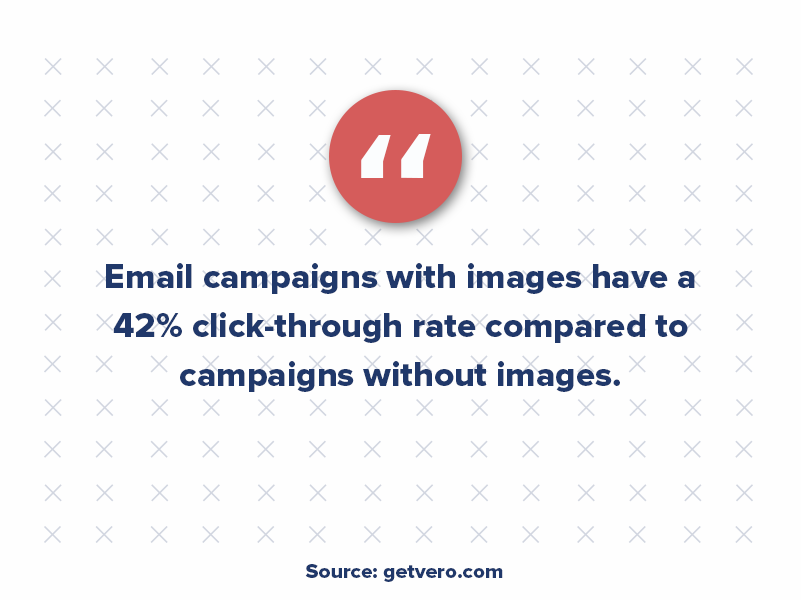
Step 5: Email Templates
Design visually appealing email templates that are mobile-responsive and user-friendly. Your templates should align with your brand’s identity and make it easy to present your content effectively. Many email marketing platforms offer customizable templates for this purpose.
Step 6: Scheduling and Automation
Set up an email schedule that aligns with your content calendar. Automation tools within your email marketing platform can help you schedule emails in advance, ensuring timely delivery to your audience. Automation also allows you to segment emails based on user actions and preferences.
Step 7: Personalization
Implement personalization tactics within your emails. Use recipient names, dynamic content, and personalized recommendations based on their past interactions with your emails. Personalization adds a human touch and increases engagement.
Step 8: Testing and Optimization
Regularly test different elements of your emails, such as subject lines, content layout, and visuals. Analyze open, click-through, and conversion rates to identify what works best for your audience. Use these insights to optimize your content and email strategies continuously.
Step 9: Reporting and Analysis
Leverage the analytics provided by your email marketing platform to track the performance of your emails. Monitor key metrics like engagement, unsubscribe rates, and conversion rates. Use this data to refine your content marketing workflow and make informed decisions.
Step 10: Feedback Loop
Encourage feedback from your audience. Provide opportunities for subscribers to share their thoughts and preferences. Use their input to fine-tune your content and ensure it consistently meets their expectations.
Which Email Automation Platform Is Best?
While numerous email marketing platforms exist, Go High Level and Hubspot are two of our favorites. This platform offers an all-in-one solution for multifamily businesses, encompassing a wide range of marketing automation tools within a single platform. This comprehensive approach simplifies your email marketing endeavors by consolidating campaign management, CRM integration, and lead tracking under one roof.
Automation is at the core of Go High Level’s capabilities. You can automate lead nurturing, follow-up sequences, and even appointment scheduling. The platform also seamlessly integrates with other tools and platforms, including CRM systems and lead generation tools, allowing you to build a cohesive marketing ecosystem.
Automation is the key to unlocking the full potential of your multifamily email marketing strategy. It’s the tool that can help you streamline your efforts, improve lead management, and deliver measurable results. By embracing marketing automation workflows and leveraging tools like Go High Level, you can elevate your email marketing services and stay ahead in the multifamily industry.



